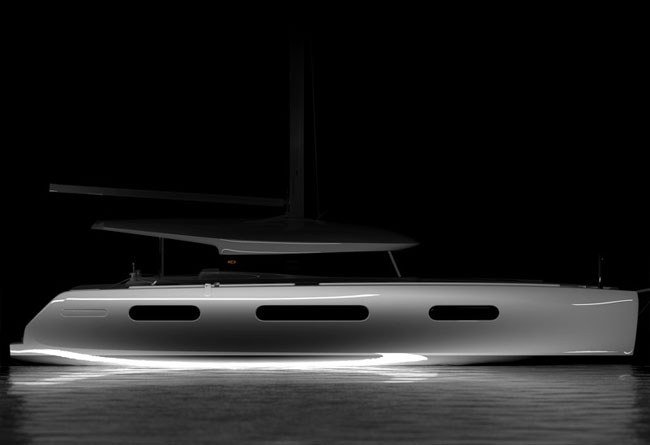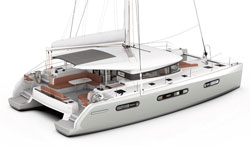

When the world's biggest yacht builder decided to lean a little harder on the loud pedal they were clearly in no mood to mess around...
There’s a great big gap right in the middle of the multihull market and Groupe Bénéteau has launched a whole new brand to fill it. With its allnew Excess catamarans, the world’s biggest boatbuilder is forging a sporty, modern and youthful brand identity, offering a new generation of multihull sailors an alternative to what has become, in effect, a binary choice between skittish, hull-flying racing machines on one hand and sedate holiday cruisers on the other. The first boats are in build at the time of writing and two models, the 39ft Excess 12 and the 49ft Excess 15, are set to make their boat show début at Cannes this September.
‘The market is a broad spectrum with high-performance boats at one end and comfortable cruisers, which are optimised for charter use, at the other,’ says Bruno Belmont, the product designer for Excess Catamarans. ‘About 90 per cent of the market – including our own very successful brand, Lagoon – is clustered tightly together at the comfort end of the spectrum. There are some well-established niche brands at the performance end, but there is a big gap in the centre.’
A naval architect by vocation – he trained at Southampton in the 1980s alongside Marc Van Peterghem and Vincent Lauriot-Prévost, who became VPLP – Belmont is one of the key figures within the multihull production industry, previously serving as general project designer at Lagoon. Sailing has changed quite significantly over the last few decades, he says, and the monohull production market is now only about half of what it was at its peak in 2008. Even the market leaders, like Bénéteau, are building half as many boats as they used to, focusing on larger, higher-value boats. ‘We used to build about 1,200 sailing yachts each year; now it’s closer to 600,’ he says. ‘Effectively, 600 buyers are missing and we began to ask ourselves what had happened. There must be something changing in the way people sail.’
Back in the peak monohull days, Belmont explains, ‘the typical new boat buyer was one guy imposing his will on the rest of his family. There has been a reaction against that type of sailing and monohull sales have tailed off as a consequence. Now many people tend to charter instead of buying a boat. The most popular choice is a big, comfortable cruising catamaran, which is perfect for a family holiday but less rewarding to sail for the experienced owner.’
Excess is a cruising brand inspired by racing, aimed at experienced sailors who want to buy a boat rather than charter – people who sail for the pleasure of sailing, cruising long distances from mooring to mooring rather than making short hops from port to port. Excess cats are designed to deliver the main advantages of a comfortable cruising multihull, but also to be fun and engaging to sail, rewarding the crew for keeping the sails well trimmed and restoring that sense of pleasure at the wheel.
The twin helms are positioned aft and outboard of the accommodation, racing style, rather than being cocooned inside or perched atop the cabin superstructure. This configuration also puts the helmsman right next to the rest of the crew, which makes for more sociable sailing. The helm stations have been designed to give clear sight lines forward and a good view to leeward through the yacht’s superstructure, while offering a commanding, unobstructed view of the sails. Dyneema steering cables are fitted as standard to improve the responsiveness, sensitivity and ‘feel’ of the helm.
The hulls, platforms and rigs are designed by VPLP, the world’s preeminent multihull design team, which has won the last Route du Rhum with the Ultime racing tri Idec. Platform length is an important parameter in catamaran design, which dictates both the sailing performance and the size of the accommodation on board. The longer the platform, the larger the main living space can be, but then more volume is required in the hulls and particularly in the bows to avoid excessive pitching and ensure a seaworthy boat, which produces a commensurate increase in drag under way and thus a reduction in boatspeed. The hull length to platform length ratio of a highperformance cat is usually around 2:1. For a typical cruising cat, most offers are set around 1:35 but some boats have numbers very close to 1:1. For Excess catamarans, the hullto- platform length ratio is roughly halfway between these extremes.
Hull shape is another fine balancing act between performance and comfort. While slimmer and more easily driven than most cruising cats, the Excess boats have long keels with a moderate draught of 1.35 to 1.4m (4ft 5in to 4ft 7in) rather than relying on daggerboards for lateral resistance. This removes the complication of adjusting daggerboards under way, reduces the cost of construction and enables the boats to take the ground in tidal anchorages without putting any strain on rudders and saildrives – which is a big advantage in many cruising grounds.
To launch their new range, Excess are giving away a brand new boat in a unique competition – a virtual regatta that’s aimed at experienced sailors and designed to test your passage planning, navigation, racing tactics and weather routing skills.
The Excess Challenge involves racing an Excess Cat in real time, with real weather data in hourly increments, across the Mediterranean from Barcelona to Cannes via the Balearic Islands and the Strait of Bonifacio, leaving Menorca and Corsica to port. You decide on the optimal time to start the race, relying on a real weather forecast since your sailing will be done in real-time weather conditions, drawing on your own knowledge and experience. You choose which sails to use and when to trim or reef them, set your course, program the autopilot (in heading or wind vane mode) and decide on your own night watch schedule. The fastest to finish wins.
It costs €9 to enter, which allows you three record attempts. The top prize is a brand new, fully equipped 11-metre Excess fast cruising catamaran worth at least €300,000. Other prizes include a range of one-week charter holidays aboard an Excess cat, from a cabin for two on a shared charter to exclusive use of the four-cabin boat.
All entrants have a chance of winning the top prize, but your sailing performance in the Challenge can dramatically improve your chances of winning. The overall winner has his or her chances boosted by 50 per cent; the second fastest to finish gets a 20 per cent boost, and the third fastest 10%. There’s also a team challenge option for up to four players.
To enter the Excess Challenge, to find out more about it and to read the rules, please click here to visit the website...
Weight saving is another key design parameter for the Excess range – but without resorting to the carbon fibre construction that makes most high-performance multihulls prohibitively expensive. Instead, the interior furniture is carefully engineered to be 30 per cent lighter than you’ll find on a typical cruising cat. Another substantial weight saving is achieved by mounting the mainsheet track on the aft beam, rather on the cabin top (which must be heavily reinforced if you want it to take mainsheet loads safely).

Above: Excess aim to restore the joy of being at the wheel. The helm stations are located as far aft and outboard as possible – similar to most racing multihulls – with clear sight lines forward and a commanding view of the sails. The platform is shorter and the hulls are slimmer than on a typical cruising cat, but there’s still plenty of living space.
Below: The Excess range starts from 11 metres to 15 metres with five models. The first Excess 12 and 15s will be on show at the Cannes Yachting Festival in September
The Excess cats will also have more powerful, less conservative sailplans than your average cruising cat. All boats in the range will have the trademark VPLP rig configuration, designed to minimise pitching: an ultra-high aspect sailplan with a big, square-topped mainsail on a mast located quite far aft, supported by a compression post in the saloon. There are two rig options, both of which offer significantly higher sail area-displacement ratios – and hence more boatspeed potential – than any of the yachts at the ‘comfort’ end of the multihull spectrum. The standard rig gives about five per cent more SA:D and the optional Pulse Line rig delivers a further 10 per cent of performance potential.
Aesthetics are crucial, Belmont says. Excess owners will expect their yacht to be beautiful as well as functional with a sleek and resolutely modern silhouette. Excess cats will of course have spacious cabins with Queen-size beds and all mod cons, but the lightweight luxury interior fitout will make a virtue of simplicity, saving weight without compromising the quality of furnishings. On deck, the stanchions and cleats are aluminium plated with titanium.
One notable departure from the normal way of doing things is the pricing structure for Excess catamarans. Most yachts are marketed at a “base price”, which can seem misleadingly low after “optional” but effectively essential items such as a windlass, sails and an electrical charging system are added. Excess, by contrast, quotes a standard price for a boat that’s genuinely ready to sail. The range will be competitively priced for a luxury brand, at around €305,000 to €315,000 for the 12m boat and €580,000 to €598,000 for the 15m boat. Next up on the production schedule is an 11-metre Excess cat, due to be launched at Düsseldorf Boat Show in January 2020. 13m and 14m boats are also planned to complete the range.

Click here for more information on Excess Catamarans »
We invite you to read on and find out for yourself why Seahorse is the most highly-rated source in the world for anyone who is serious about their racing.
To read on simply SIGN up NOW
Take advantage of our very best subscription offer or order a single copy of this issue of Seahorse.
Online at:
www.seahorse.co.uk/shop and use the code TECH20
Or for iPad simply download the Seahorse App at the iTunes store


